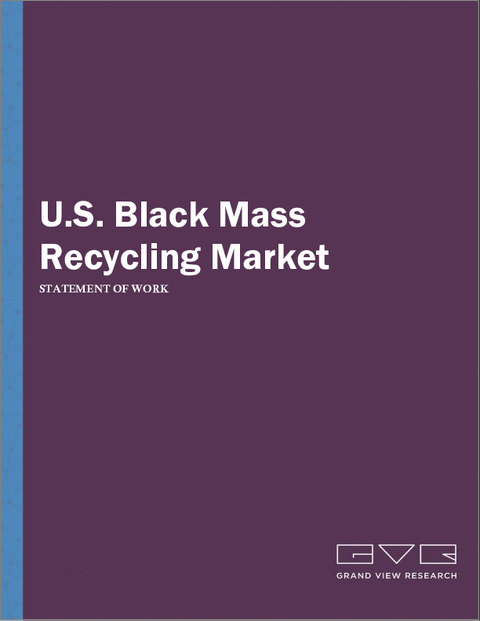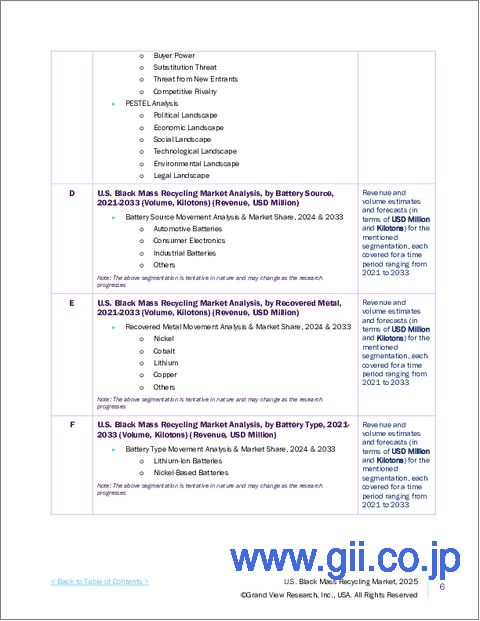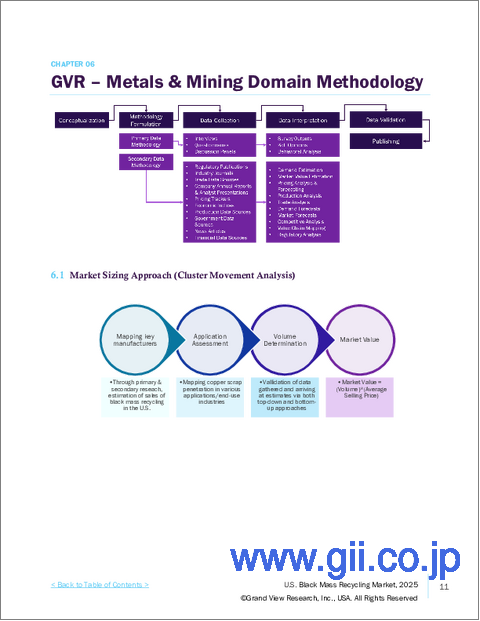|
|
市場調査レポート
商品コード
1771581
米国のブラックマスリサイクル市場規模、シェア、動向分析レポート:電池タイプ別、バッテリーソース別、回収金属別、セグメント予測、2025~2033年U.S. Black Mass Recycling Market Size, Share & Trends Analysis Report By Battery Type, By Battery Source, By Recovered Metals, And Segment Forecasts, 2025 - 2033 |
||||||
カスタマイズ可能
|
|||||||
| 米国のブラックマスリサイクル市場規模、シェア、動向分析レポート:電池タイプ別、バッテリーソース別、回収金属別、セグメント予測、2025~2033年 |
|
出版日: 2025年06月12日
発行: Grand View Research
ページ情報: 英文 80 Pages
納期: 2~10営業日
|
全表示
- 概要
- 図表
- 目次
米国のブラックマスリサイクル市場サマリー
米国のブラックマスリサイクル市場規模は、2024年に11億6,000万米ドルと評価され、2033年には47億5,000万米ドルに達し、2025年から2033年までのCAGRは17.2%で成長すると予測されています。バッテリー廃棄の増加動向は、ブラックマスリサイクル施設の一貫した原料を生み出し、米国の市場成長を促進します。
米国では2024年に電池式電気自動車の導入が加速し、自動車メーカーは消費者と規制当局の需要増に対応するために生産規模を拡大した。テスラ、フォード、ゼネラル・モーターズなどの企業が国内のEV生産を大幅に拡大し、EVエコシステムの拡大に貢献しました。このような生産量の急増は、当然ながら、車両の引退や製造上のスクラップによって使用済みとなるリチウムイオン電池の量を増やす結果となりました。その結果、リチウム、コバルト、ニッケルなどの貴重な電池用金属からなる黒液の利用可能量が大幅に増加しました。
米国を拠点とする黒質リサイクル業者は、大規模なインフラ拡張と資本集約的プロジェクトで対応してきました。レッドウッド・マテリアルズ社は、2026年までに、ブラックマスから回収した鉱物を使用して、年間100GWh、100万台以上のEVに電力を供給するのに十分な正極活物質を生産することを目指すと発表しました。アセンド・エレメンツはまた、2024年にケンタッキー州ホプキンスビルに6,500万米ドルのリサイクル施設を建設し、その地位を前進させました。この工場では、年間最大2万4,000トンのリチウムイオン電池材料を処理する予定です。これらの開発は、事業を拡大し、リサイクル効率を向上させ、増加する国内のバッテリー廃棄物の流れから価値を獲得する戦略的な動きを示しています。
政府の支援は、特に金融優遇措置と融資保証を通じて、2024年の勢いを強めました。レッドウッド・マテリアルズは、ネバダ州を拠点とするリサイクル施設を拡張するため、エネルギー省の先進技術自動車製造プログラムから20億米ドルの融資を受けた。このような政府の支援は、リサイクル企業の財務リスクを軽減し、処理能力と技術の拡大に必要な流動性を提供します。このような連邦政府の関与は、特にコバルトやリチウムのような素材に地政学的供給リスクが絡む中、重要な鉱物のサプライチェーンを地域化し、海外供給源への依存を減らすという、より広範な国家的取り組みを反映しています。
市場の安定に不可欠なのは、リサイクル業者と相手先商標製品製造業者(OEM)とのクローズドループパートナーシップの形成です。レッドウッドマテリアルズがトヨタ自動車やパナソニックと提携したことで、バッテリーの製造スクラップや使用済みバッテリーを処理するための信頼できる流れが確保されました。同様に、アセンドエレメンツはSKエコプラント社と提携し、リサイクルされた黒色マスを高価値の正極前駆体材料に変換しています。これらの契約により、リサイクル業者は一貫した投入原料を入手できるようになり、自動車メーカーは回収鉱物を新たなバッテリー生産に再組み入れすることで、持続可能性の目標を達成することができます。このようなループを確立することは、米国内で電池材料の循環型経済を構築する上で極めて重要です。
最後に、厳しい規制の枠組みと環境・社会・ガバナンス(ESG)に対する期待の高まりは、2024年も引き続き中心的な役割を果たします。インフレ抑制法(IRA)やその他の連邦・州レベルのイニシアチブは、国内のリサイクルを奨励し、環境に有害な廃棄行為に罰則を科すものです。バッテリーの寿命末期管理に対する監視が強化される中、米国のリサイクル業者は、低炭素EVサプライチェーンに不可欠な貢献者として位置づけられています。このような政策は産業投資を促進し、黒字の大量リサイクルがクリーンエネルギーへの移行、資源の自立、長期的な持続可能性といったより広範な目標に合致することを確実にします。
目次
第1章 調査手法と範囲
第2章 エグゼクティブサマリー
第3章 市場の変数、動向、範囲
- 世界のブラックマスリサイクル市場の展望
- 業界バリューチェーン分析
- 販売チャネル分析
- テクノロジーの概要
- 規制の枠組み
- 市場力学
- 市場促進要因分析
- 市場抑制要因分析
- 業界動向
- ESG分析
- 経済動向
- ポーターのファイブフォース分析
- 供給企業の交渉力
- 買い手の交渉力
- 代替の脅威
- 新規参入業者の脅威
- 競争企業間の敵対関係
- PESTLE分析
- 政治的
- 経済
- 社会情勢
- テクノロジー
- 環境
- 法律上
第4章 米国のブラックマスリサイクル市場:電池タイプの推定・動向分析
- 米国のブラックマスリサイクル市場:電池タイプの変動分析、2024年および2033年
- リチウムイオン電池
- ニッケルベースの電池
第5章 米国のブラックマスリサイクル市場:バッテリーソースの推定・動向分析
- 米国のブラックマスリサイクル市場:バッテリーソースの変動分析、2024年および2033年
- 自動車用バッテリー
- 家電用バッテリー
- 産業用バッテリー
- その他
第6章 米国のブラックマスリサイクル市場:回収金属の推定・動向分析
- 米国のブラックマスリサイクル市場:回収金属の変動分析、2024年および2033年
- ニッケル
- コバルト
- リチウム
- 銅
- その他
第7章 競合情勢
- 主要市場参入企業による最近の動向と影響分析
- 企業分類
- ヒートマップ分析
- ベンダー情勢
- 販売代理店一覧
- List of prospective end-users
- Strategy Initiatives
- 企業プロファイル/上場企業
- Redwood Materials Inc.
- Ascend Elements, Inc.
- American Battery Technology Company
- Aqua Metals, Inc.
- RecycLiCo Battery Materials Inc.
- Retrieve
- Green Li-ion Pte Ltd.
- Lifecycle Renewables
- Elemental Holding SA
- ECOBAT
List of Tables
- Table 1 U.S. black mass recycling market estimates & forecasts, 2021 - 2033 (USD Million) (Kilotons)
- Table 2 U.S. black mass recycling market estimates and forecasts, by lithium ion batteries, 2021 - 2033 (USD Million) (Kilotons)
- Table 3 U.S. black mass recycling market estimates and forecasts, by nickel-based batteries, 2021 - 2033 (USD Million) (Kilotons)
- Table 4 U.S. black mass recycling market estimates and forecasts, by automotive batteries, 2021 - 2033 (USD Million) (Kilotons)
- Table 5 U.S. black mass recycling market estimates and forecasts, by consumer electronics, 2021 - 2033 (USD Million) (Kilotons)
- Table 6 U.S. black mass recycling market estimates and forecasts, by industrial batteries, 2021 - 2033 (USD Million) (Kilotons)
- Table 7 U.S. black mass recycling market estimates and forecasts, by other batteries, 2021 - 2033 (USD Million) (Kilotons)
- Table 8 U.S. black mass recycling market estimates and forecasts, by nickel, 2021 - 2033 (USD Million) (Kilotons)
- Table 9 U.S. black mass recycling market estimates and forecasts, by cobalt, 2021 - 2033 (USD Million) (Kilotons)
- Table 10 U.S. black mass recycling market estimates and forecasts, by lithium, 2021 - 2033 (USD Million) (Kilotons)
- Table 11 U.S. black mass recycling market estimates and forecasts, by copper, 2021 - 2033 (USD Million) (Kilotons)
- Table 12 U.S. black mass recycling market estimates and forecasts, by other metals, 2021 - 2033 (USD Million) (Kilotons)
List of Figures
- Fig. 1 Market segmentation
- Fig. 2 Information procurement
- Fig. 3 Data analysis models
- Fig. 4 Market formulation and validation
- Fig. 5 Market snapshot
- Fig. 6 Segmental outlook
- Fig. 7 Competitive outlook
- Fig. 8 US black mass recycling market outlook, 2021 - 2033 (USD Million) (Kilotons)
- Fig. 9 Value chain analysis
- Fig. 10 Market dynamics
- Fig. 11 Porter's analysis
- Fig. 12 PESTEL analysis
- Fig. 13 U.S. black mass recycling market, by battery source: Key takeaways
- Fig. 14 U.S. black mass recycling market, by battery source: Market share, 2024 & 2033
- Fig. 15 U.S. black mass recycling market, by recovered metal: Key takeaways
- Fig. 16 U.S. black mass recycling market, by recovered metal: Market share, 2024 & 2033
- Fig. 17 U.S. black mass recycling market, by battery type: Key takeaways
- Fig. 18 U.S. black mass recycling market, by battery type: Market share, 2024 & 2033
U.S. Black Mass Recycling Market Summary
The U.S. black mass recycling market size was valued at USD 1.16 billion in 2024 and is projected to reach USD 4.75 billion by 2033, growing at a CAGR of 17.2% from 2025 to 2033. Upward trend in battery disposal creates consistent feedstock for black mass recycling facilities, thus driving market growth in the U.S.
The deployment of battery-electric vehicles in the U.S. accelerated in 2024, with automakers scaling production to meet rising consumer and regulatory demands. Companies such as Tesla, Ford, and General Motors significantly ramped domestic EV output, contributing to the expanding EV ecosystem. This surge in production naturally resulted in a larger volume of lithium-ion batteries reaching end-of-life, either through vehicle retirement or manufacturing scrap. As a result, the availability of black mass, comprising valuable battery metals like lithium, cobalt, and nickel, increased substantially.
U.S.-based black mass recyclers have responded with large-scale infrastructure expansion and capital-intensive projects. Redwood Materials announced that by 2026, it aims to produce 100 GWh of cathode-active materials annually, enough to power over one million EVs, using recovered minerals from the black mass. Ascend Elements also advanced its position in 2024 by constructing a USD 65 million recycling facility in Hopkinsville, Kentucky. This plant is projected to process up to 24,000 metric tons of lithium-ion battery material annually. These developments indicate a strategic move towards scaling operations, improving recycling efficiency, and capturing value from a growing domestic battery waste stream.
Government support strengthened the momentum in 2024, particularly through financial incentives and loan guarantees. Redwood Materials secured a USD 2 billion loan from the Department of Energy's Advanced Technology Vehicles Manufacturing program to expand its Nevada-based recycling facility. This governmental backing mitigates financial risk for recycling companies and provides the liquidity needed to expand processing capacities and technologies. Such federal involvement reflects broader national efforts to localize critical mineral supply chains and reduce dependency on overseas sources, particularly amid geopolitical supply risks tied to materials like cobalt and lithium.
A critical enabler of market stability has been the formation of closed-loop partnerships between recyclers and original equipment manufacturers (OEMs). Redwood Materials' collaborations with Toyota and Panasonic ensured a reliable stream of battery production scrap and end-of-life batteries for processing. Similarly, Ascend Elements partnered with SK Ecoplant to convert recycled black mass into high-value cathode precursor materials. These agreements ensure recyclers can access consistent input material and help automakers meet sustainability goals by reintegrating recovered minerals into new battery production. Establishing such loops is pivotal to building a circular economy for battery materials within the U.S.
Lastly, stringent regulatory frameworks and rising environmental, social, and governance (ESG) expectations continue to play a central role in 2024. The Inflation Reduction Act (IRA) and other federal and state-level initiatives incentivize domestic recycling and penalize environmentally harmful disposal practices. With increased scrutiny on battery end-of-life management, U.S. recyclers are positioned as essential contributors to a lower-carbon EV supply chain. These policy levers encourage industrial investment and ensure that black mass recycling aligns with broader goals of clean energy transition, resource independence, and long-term sustainability.
U.S. Black Mass Recycling Market Report Segmentation
This report forecasts revenue and volume growth at the country level and analyzes the latest industry trends in each of the sub-segments from 2021 to 2033. For the purpose of this study, Grand View Research has segmented the U.S. black mass recycling market report by battery type, battery source, and recovered metal.
- Battery Type Outlook (Revenue, USD Million; Volume, Kilotons; 2021 - 2033)
- Lithium-Ion Batteries
- Nickel-Based Batteries
- Battery Source Outlook (Revenue, USD Million; Volume, Kilotons; 2021 - 2033)
- Automotive Batteries
- Consumer Electronics
- Industrial Batteries
- Others
- Recovered Metal Outlook (Revenue, USD Million; Volume, Kilotons; 2021 - 2033)
- Nickel
- Cobalt
- Lithium
- Copper
- Others
Table of Contents
Chapter 1. Methodology and Scope
- 1.1. Market Segmentation & Scope
- 1.2. Market Definition
- 1.3. Information Procurement
- 1.3.1. Information Analysis
- 1.3.2. Data Analysis Models
- 1.3.3. Market Formulation & Data Visualization
- 1.3.4. Data Validation & Publishing
- 1.4. Research Scope and Assumptions
- 1.4.1. List of Data Sources
Chapter 2. Executive Summary
- 2.1. Market Outlook
- 2.2. Segmental Outlook
- 2.3. Competitive Outlook
Chapter 3. Market Variables, Trends, and Scope
- 3.1. Global Black Mass Recycling Market Outlook
- 3.2. Industry Value Chain Analysis
- 3.2.1. Sales Channel Analysis
- 3.3. Technology Overview
- 3.4. Regulatory Framework
- 3.5. Market Dynamics
- 3.5.1. Market Driver Analysis
- 3.5.2. Market Restraint Analysis
- 3.6. Industry Trends
- 3.6.1. ESG Analysis
- 3.6.2. Economic Trends
- 3.7. Porter's Five Forces Analysis
- 3.7.1. Bargaining Power of Suppliers
- 3.7.2. Bargaining Power of Buyers
- 3.7.3. Threat of Substitution
- 3.7.4. Threat of New Entrants
- 3.7.5. Competitive Rivalry
- 3.8. PESTLE Analysis
- 3.8.1. Political
- 3.8.2. Economic
- 3.8.3. Social Landscape
- 3.8.4. Technology
- 3.8.5. Environmental
- 3.8.6. Legal
Chapter 4. U.S. Black Mass Recycling Market: Battery Type Estimates & Trend Analysis
- 4.1. U.S. Black Mass Recycling Market: Battery Type Movement Analysis, 2024 & 2033
- 4.2. Lithium-Ion Batteries
- 4.2.1. Market estimates and forecasts, 2021 - 2033 (USD Million) (Kilotons)
- 4.3. Nickel-Based Batteries
- 4.3.1. Market estimates and forecasts, 2021 - 2033 (USD Million) (Kilotons)
Chapter 5. U.S. Black Mass Recycling Market: Battery Source Estimates & Trend Analysis
- 5.1. U.S. Black Mass Recycling Market: Battery Source Movement Analysis, 2024 & 2033
- 5.2. Automotive Batteries
- 5.2.1. Market estimates and forecasts, 2021 - 2033 (USD Million) (Kilotons)
- 5.3. Consumer Electronics
- 5.3.1. Market estimates and forecasts, 2021 - 2033 (USD Million) (Kilotons)
- 5.4. Industrial Batteries
- 5.4.1. Market estimates and forecasts, 2021 - 2033 (USD Million) (Kilotons)
- 5.5. Others
- 5.5.1. Market estimates and forecasts, 2021 - 2033 (USD Million) (Kilotons)
Chapter 6. U.S. Black Mass Recycling Market: Recovered Metals Estimates & Trend Analysis
- 6.1. U.S. Black Mass Recycling Market: Recovered Metals Movement Analysis, 2024 & 2033
- 6.2. Nickel
- 6.2.1. Market estimates and forecasts, 2021 - 2033 (USD Million) (Kilotons)
- 6.3. Cobalt
- 6.3.1. Market estimates and forecasts, 2021 - 2033 (USD Million) (Kilotons)
- 6.4. Lithium
- 6.4.1. Market estimates and forecasts, 2021 - 2033 (USD Million) (Kilotons)
- 6.5. Copper
- 6.5.1. Market estimates and forecasts, 2021 - 2033 (USD Million) (Kilotons)
- 6.6. Others
- 6.6.1. Market estimates and forecasts, 2021 - 2033 (USD Million) (Kilotons)
Chapter 7. Competitive Landscape
- 7.1. Recent Developments & Impact Analysis, By Key Market Participants
- 7.2. Company Categorization
- 7.3. Heat Map Analysis
- 7.4. Vendor Landscape
- 7.4.1. List of distributors
- 7.5. List of prospective end-users
- 7.6. Strategy Initiatives
- 7.7. Company Profiles/Listing
- 7.7.1. Redwood Materials Inc.
- 7.7.1.1. Company Overview
- 7.7.1.2. Financial Performance
- 7.7.1.3. Product Benchmarking
- 7.7.2. Ascend Elements, Inc.
- 7.7.2.1. Company Overview
- 7.7.2.2. Financial Performance
- 7.7.2.3. Product Benchmarking
- 7.7.3. American Battery Technology Company
- 7.7.3.1. Company Overview
- 7.7.3.2. Financial Performance
- 7.7.3.3. Product Benchmarking
- 7.7.4. Aqua Metals, Inc.
- 7.7.4.1. Company Overview
- 7.7.4.2. Financial Performance
- 7.7.4.3. Product Benchmarking
- 7.7.5. RecycLiCo Battery Materials Inc.
- 7.7.5.1. Company Overview
- 7.7.5.2. Financial Performance
- 7.7.5.3. Product Benchmarking
- 7.7.6. Retrieve
- 7.7.6.1. Company Overview
- 7.7.6.2. Financial Performance
- 7.7.6.3. Product Benchmarking
- 7.7.7. Green Li-ion Pte Ltd.
- 7.7.7.1. Company Overview
- 7.7.7.2. Financial Performance
- 7.7.7.3. Product Benchmarking
- 7.7.8. Lifecycle Renewables
- 7.7.8.1. Company Overview
- 7.7.8.2. Financial Performance
- 7.7.8.3. Product Benchmarking
- 7.7.9. Elemental Holding S.A.
- 7.7.9.1. Company Overview
- 7.7.9.2. Financial Performance
- 7.7.9.3. Product Benchmarking
- 7.7.10. ECOBAT
- 7.7.10.1. Company Overview
- 7.7.10.2. Financial Performance
- 7.7.10.3. Product Benchmarking
- 7.7.1. Redwood Materials Inc.





